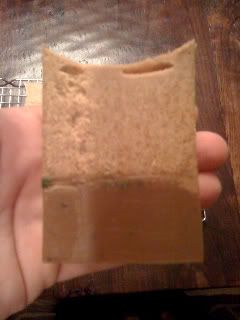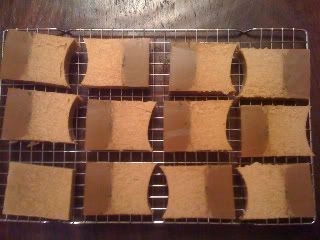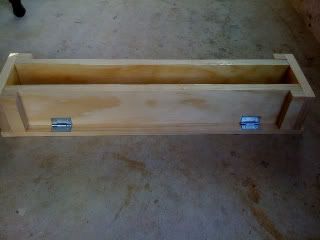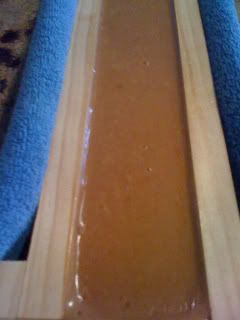vegoilrecycler
New Member
- Joined
- Aug 1, 2008
- Messages
- 4
- Reaction score
- 0
Hello.
Thanks to all who contribute here.
I am having newbie issues with my lye soap. It's got a solid consistency on the bottom and a foamy/spongy consistency on top. I'd like the soap to have the solid consistency throughout. It looks better and feels much more solid. I think heat control during the pouring or just after pouring into the mold allowed air bubbles to not escape and set into the top half of the slab.


I'm not what would be considered a traditional soaper. I produce biodiesel from soft oils and have loads of rich glycerin left over. It's dark brown in color like a Guiness Stout beer. That's where the color in the soap is coming from. The soap itself is mainly from Steric Acid. There's a little bit of Coconut oil and olive oil added in for their beneficial properties. All of it is fully saponified with NaOH lye and the "hot process method." Hopefully that explains why my soap doesn't look like your soap (brown color) and I know there's issues which are already present because of the non-traditional ingredients.
My hope is that you could take a look at the pic of my bar and tell me if you've seen this problem AND if you've overcome it with some modifications to your process or mold or something else.
The bar in the pic above was poured into a wooden mold. The mold is 3-1/2" deep X 2-3/8" wide X 24" long.



More details leading up to the pouring:
I added in enough lye to keep the soap hot after 1 hour of cooking at 160F. I was using a double-boiler to keep from scalding the material. After making sure the entire mixture was fully saponified, I then added in the olive oil and coconut oil in increments (cooking for 20 minutes after each 2 oz addition) until it wasn't hot anymore. I'm fairly certain that the mixture is less than 5% superfatted.
I let the soap cool down a bit before scenting. I poured the soap at a temp which was probably in the neighborhood of 130F. Maybe too cool? After pouring the soap into the wood mold, I put towels around it to keep it insulated. This was suggested to me by a traditional soaper that I met at a flea market over the weekend. Within 45 minutes, the soap began to sag on the top. You can see the evidence of this in the cut bar which is a cross-section of the slab. It's got a concave top edge.
The soap is scented with Mint Rosemary. It lathers nicely, conditions nicely, and smells great! I just want it to look great.
Thanks for reading my huge post and I look forward to any helpful suggestions.
Thanks to all who contribute here.
I am having newbie issues with my lye soap. It's got a solid consistency on the bottom and a foamy/spongy consistency on top. I'd like the soap to have the solid consistency throughout. It looks better and feels much more solid. I think heat control during the pouring or just after pouring into the mold allowed air bubbles to not escape and set into the top half of the slab.


I'm not what would be considered a traditional soaper. I produce biodiesel from soft oils and have loads of rich glycerin left over. It's dark brown in color like a Guiness Stout beer. That's where the color in the soap is coming from. The soap itself is mainly from Steric Acid. There's a little bit of Coconut oil and olive oil added in for their beneficial properties. All of it is fully saponified with NaOH lye and the "hot process method." Hopefully that explains why my soap doesn't look like your soap (brown color) and I know there's issues which are already present because of the non-traditional ingredients.
My hope is that you could take a look at the pic of my bar and tell me if you've seen this problem AND if you've overcome it with some modifications to your process or mold or something else.
The bar in the pic above was poured into a wooden mold. The mold is 3-1/2" deep X 2-3/8" wide X 24" long.



More details leading up to the pouring:
I added in enough lye to keep the soap hot after 1 hour of cooking at 160F. I was using a double-boiler to keep from scalding the material. After making sure the entire mixture was fully saponified, I then added in the olive oil and coconut oil in increments (cooking for 20 minutes after each 2 oz addition) until it wasn't hot anymore. I'm fairly certain that the mixture is less than 5% superfatted.
I let the soap cool down a bit before scenting. I poured the soap at a temp which was probably in the neighborhood of 130F. Maybe too cool? After pouring the soap into the wood mold, I put towels around it to keep it insulated. This was suggested to me by a traditional soaper that I met at a flea market over the weekend. Within 45 minutes, the soap began to sag on the top. You can see the evidence of this in the cut bar which is a cross-section of the slab. It's got a concave top edge.
The soap is scented with Mint Rosemary. It lathers nicely, conditions nicely, and smells great! I just want it to look great.
Thanks for reading my huge post and I look forward to any helpful suggestions.














































